Tag Archive for: MLL Rearrangement
Elevate | What You Should Know About Your Role in AML Treatment and Care Decisions
Elevate | What You Should Know About Your Role in AML Treatment and Care Decisions from Patient Empowerment Network on Vimeo.
Related Resources:
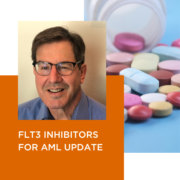
|

Thriving With AML | Advice for Setting Goals and Making Treatment Decisions |
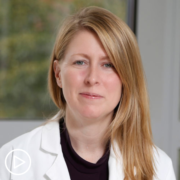
Expert Advice | Managing AML Symptoms and Treatment Side Effects |
Transcript:
Katherine Banwell:
Hello, and welcome. I’m your host, Katherine Banwell. It’s no secret that the quality-of-care patients receive can vary, and patients who are educated about their condition and involved in their care may have improved outcomes. That’s why the Patient Empowerment Network created the Elevate series, to help AML patients and their care partners feel well-informed when making treatment decisions with their healthcare team.
In today’s program, an AML expert will join us to share advice for accessing better overall care. Before we get into the discussion, please remember that this program is not a substitute for seeking medical advice. Please refer to your healthcare team about what might be best for you. Well, let’s meet our guest today. Joining us is Dr. Gail Roboz. Dr. Roboz, would you please introduce yourself?
Dr. Gail Roboz:
Absolutely. Thank you so much for having me. My name is Gail Roboz. I’m a professor of medicine and director of the clinical and translational leukemia programs at Weill Cornell Medicine and the NewYork-Presbyterian Hospital in New York City. Thank you again for having me.
Katherine Banwell:
Well, thank you so much for joining us today. We really appreciate it. I’d like to start by discussing your role as a researcher. You’re on the frontlines for advancements in the AML field. What led you here, and why is it important to you?
Dr. Gail Roboz:
So, I’m actually asked that question quite frequently, because AML is a challenging, difficult, scary disease, and people don’t necessarily assume that somebody in medical school would gravitate toward it.
But I have to say that what is incredibly fascinating back then and now about leukemia is the continuous access to the disease. Patients will maybe giggle or groan as I’m saying that, because you can get a blood sample really anytime. You can even get a bone marrow sample anytime, although patients don’t enjoy that so much.
But from a research perspective, it is absolutely extraordinary to be dealing with a disease where you can, in real time, truly run back and forth to a laboratory and see what’s happening, what is the new drug or the old drug doing, what’s happening with the patient, and I would say that from a fascination of a medical student perspective that grabbed me then and still does today.
Katherine Banwell:
When it comes to choosing therapy for AML, it’s important to work with your healthcare team to identify what will work best for you, the patient. So, I’d like to know how you define shared decision-making.
Dr. Gail Roboz:
The problem with AML sometimes is that it can be such an acute, emergency-type of presentation and urgent decision-making that I think your question is almost right out of the gate for some patients that will, “Wait, I don’t even have a minute, here. How do I build a team, do the research, look online if people are telling me that I’m in the middle of an emergency?”
That isn’t always the case for acute leukemia, but it sometimes is. I think that what happens in AML in particular for patients is a building of knowledge and a building of the team, and figuring out, first of all, where am I when I am being told this diagnosis, and is it really an emergency? Do I have to make decisions really right now, because is it life-threatening today, I don’t have time to look around? Or do I have a minute to pause and get more information?
I definitely feel that with the Internet era and with so much connection between doctors and teams, there is much more ability to reach out instantaneously for doctors, too, to get advice on a patient who might be in a smaller hospital that doesn’t have AML experience. But I think that the first thing is to try to figure out very, very quickly, what needs to happen to me as a patient immediately, and what can wait a minute, so that I can figure out what am I being told, and what are my options?
Katherine Banwell:
Right, right. It can be confusing for patients, just finding out this new information. Part of making care decisions is setting goals. What are AML treatment goals, and how are they determined?
Dr. Gail Roboz:
I would say that leaving cure on the table from the beginning is always a good place to start, because you want to figure out, first of all, what am I dealing with? What are the actual options?
But when AML strikes, and a patient who has multiple medical conditions or comorbidities that are truly compromising function independently of the diagnosis of AML, that’s going to be a special path of what is actually reasonable for someone who is terribly medically ill or otherwise frail right from the beginning? That can be defining goals, but I think from the beginning, the best thing is to leave everything on the table. What can actually be done to make me better, first of all, to get me out of my immediate trouble? What can be done to make me better, and if I’m getting better, well, I like that, how do I stay there?
What can be done to hang on to the state of ‘better,’ which is sometimes defined as remission? In AML, the goal is to get the bone marrow working again, functioning again, get rid of the acute emergency problem, if there is one, which there may or may not be in acute leukemia.
Sometimes it’s truly an emergency, and sometimes it isn’t. But once I get better, can I stay there? What is required to keep me with a working bone marrow for as long as possible?
But once you are starting to sort through the diagnosis, you realize that saying that somebody has acute myeloid leukemia is not telling me nearly enough information. This is a disease that is what we call biologically heterogeneous, which means there are lots of different forms. It’s like saying you’re sick. What exactly does that mean? There are lots of things that can make you sick. There are lots of different subtypes of AML, and fairly quickly in most institutions, we start getting back some information specifically on the subtype and biological characteristics of the disease.
This can be very, very important in the initial treatment planning, and depending on where you are, the information that you get back can sometimes take 24 hours, 48 hours, 72 hours, a week. So, you start learning very quickly though that, “If I’m not in a complete emergency that requires instantaneous treatment, can I get back more information about the biological subtype of the disease so that I can start treatment planning of what is my best option right out of the gate?” That’s usually called induction, or the first therapy that you’re going to get with the goal, ‘getting rid of leukemia cells and getting into remission.’ That’s part one, and then everything that comes after that is about keeping you in remission.
But for the initial goal, what is the therapy that the patient needs to get to get into remission? In order to figure that out, the good news is there are a lot of different ways to slice and dice getting into remission, and actually, it used to be such a weighty decision.
Now, I would actually encourage people to – not relax, you can never use the word ‘relax’ with acute leukemia. But there are several different induction strategies for most patients that would be okay.
So, even if you get started with one strategy and you hear five days later that another doctor might do something different, there are a lot of ways to safely get into remission. I think everybody should be pleased about the fact that we’re doing much better than we used to for patients across the board, all the way from children to much older adults, to safely getting people into remission.
Katherine Banwell:
Right. So, what sort of factors then do you take into consideration when you’re choosing a therapy?
Dr. Gail Roboz:
So, out of the gate, there are the patients that I think I referred to earlier who truly, truly are in situations based on their other diseases that there are certain treatments we would just cross out right out of the gate.
If there are patients with very, very severely compromised cardiac or renal or lung function or are terribly ill from other conditions, AML doctors will right out of the gate for those patients eliminate certain treatments. But absent that scenario, what we try to look for is the biology of the disease. Not look at the age, not look at the comorbidities unless they are so severe that they make obvious certain choices.
But rather, what I like to do is say, “What kind of AML is this, and what is the best treatment that I have to get this patient into remission?” And then ask the question, “can this particular patient handle this therapy?” Sometimes, these days, there actually may be more than one route to get to remission depending on the biology of the disease, and then, if that’s the case, then I can start getting picky and look at the individual patient. Where does the patient live? Who’s the patient’s family? What other diseases has the patient been treated for?
Is there something that I can use? If I have a choice, if there are a couple of different things that might work, how do I fit the treatment to best take care of the needs of this particular patient? If I don’t have choices, then my question is, “Okay, how do I get this patient through my one therapy that I think is the truly, truly best option?”
Katherine Banwell:
Okay. I’d like to turn to test results for a moment. What sort of tests should be done following an AML diagnosis?
Dr. Gail Roboz:
We often generally recommend a bone marrow biopsy, even if we know we can make the diagnosis from a blood test, because even though the bone marrow biopsy is not the most fun test in the world, it does offer better information for follow-up care than what you can get initially from the blood.
So, every once in a while, we do have a patient for whom a bone marrow biopsy itself for whatever reason can’t be done. But almost always, we need a bone marrow biopsy, and on that biopsy, you’re going to look under the microscope and see what the cells look like. You’re going to get back standard testing, which is called flow cytometry, which is going to tell the difference between what are the different cells that you’re seeing under the microscope.
But then you’re actually going to get progressively much more fancy testing, including things called chromosomes or cytogenetics, and then ultimately, the majority of patients, if at all possible, will be having mutational testing to identify certain subgroups of AML that benefit from very particular treatments. Next-generation sequencing, PCR, fusion proteins, FISH, cytogenetics, I can go on and on with all kinds of terminology that is very confusing, even to hematology fellows, let alone to patients.
Usually, we use a combination of tests to decide, “Is this patient likely to be able to be cured with chemotherapy alone, or might this patient benefit from a stem cell transplant from somebody else after they go into remission?”
That’s basically what the prognostic scoring systems used to be asking, but now it’s a lot more complicated than that. Because even in the favorable categories, even in the adverse categories, where there used to be very little subtlety, now there is a lot of subtlety.
It’s all about defining getting into remission, and what do I give you once you’re in remission to keep you there? It’s no longer this windshield wiper thing of good, bad, transplant, no transplant. There’s a lot more to AML than there used to be.
Katherine Banwell:
I’d like to add that if you, the viewer, are interested in learning more about AML testing and treatment, PEN has a number of resources available for you. You can find these at powerfulpatients.org/AML, or by scanning the QR code on your screen.
Before we get into specific treatment types, Dr. Roboz, would you provide a brief explanation of the phases of therapy for AML? You mentioned induction therapy earlier. Would you tell us what that is?
Dr. Gail Roboz:
Yeah. So, here, too, I have to say that it’s more confusing than it used to be for the following reasons. So, historically and currently, we typically talk about induction as the first therapy that you’re going to get to get into remission.
Then, the treatment paradigm is you do something to get into remission; do some treatment to get into remission. After that, in the realm of post-remission therapy, there are different things that can happen. There can be something called consolidation, which might be another round of chemotherapy. Some patients get consolidation, some patients don’t. After consolidation, there can be a transplant.
So, you get into remission, you may or may not get a little bit of what’s called consolidation chemotherapy, and then go on to a transplant.
However, sometimes either after the transplant or after chemotherapy before ever getting or instead of ever getting a transplant, there might be ongoing treatment in a lower intensity ongoing basis that is called maintenance.
So, you’ve got to think about it as induction as what happens first, consolidation is something that happens when you’re in remission, and then maintenance usually refers to ongoing therapy that is different from consolidation.
It’s usually lower intensity, easier to take, oral types of treatment that may go on and on. And just to be incredibly confusing, it’s different from something like breast cancer, where often the patients are given, “You get six cycles of this, and then you’re done.” From AML, there’s actually often not that type of an obvious plan right out of the gate for the patient.
The answer will be, “It depends.” It depends. It depends how your treatment looks at this point in time. It depends how you look at this point in time.
So then, the patients say, “Well, aren’t you going to cure me of this? What are you doing? Aren’t you going to get rid of it?” So, historically, there are some patients who get cured with chemotherapy. They get chemotherapy to get into remission, they get some chemotherapy afterwards, and there’s a cure rate for some patients with that. The majority of patients who are cured with AML get an allotransplant, or a transplant from somebody else.
Then there’s a whole group of patients where we’re asking the question now, is it possible to get those patients beyond five years – so in oncology, five years is typically defined as cure. Can we get some patients with ongoing therapy to that past-five-year mark without a transplant? That’s in the zone of the ‘coming soon.’ Don’t have a ton of patients in that group right now, but hopefully we will.
Katherine Banwell:
You’ve mentioned some various treatment types that are used to treat AML. Can you share a brief overview of available treatments?
Dr. Gail Roboz:
So, the terminology that we use is a little bit annoying, because it is a little bit general. We say intensive and not intensive.
But historically, intensive chemotherapy referred to a combination of generally two types of agents, cytarabine (Cytosar-U) and an anthracycline, which is a class of chemotherapy, that either just those two together or in combination with sometimes a third or a fourth drug usually keeps people in the hospital for around a month. Not that the chemotherapy takes that long, but the treatment gets rid of basically a lot of cells in the bone marrow, good guys and bad guys, and it takes about three weeks for those normal cells to recover.
So, a standard intensive induction for AML is often around three to four weeks in the hospital, somewhere between three and five or so days of chemotherapy up front, depending on exactly what the protocol is. The classic regimen is actually still called 3+7, three days of one drug, seven of the other. But there are many variations of that that work.
The chemo is then stopped, the patient hangs out in the hospital, very frequently getting transfusions and antibiotics, and we wait for the bone marrow to recover.
Another current path that many patients are getting – almost all older patients, with ‘older’ being defined not by a specific age cutoff, but often 75 and older, almost everybody agrees no longer gets the classic chemotherapy that I just described. At some institutions, that 75 is going down, and even 70 and 65 and above are getting a new type of therapy, mostly because the new type of therapy is working pretty well. That is a combination of something called a hypomethylating agent.
Drugs like azacitidine (Vidaza, Onureg) or decitabine (Dacogen) in combination with a pill that has changed the landscape of AML more than any other called venetoclax (Venclexta). Venetoclax is a drug that is not exclusively used for AML.
It actually was originally approved for another type of leukemia. But I think that not many people would argue with the statement that what has changed absolutely the face of AML treatment has been this drug, because it’s a BCL2 inhibitor. What it does is it actually – cancer cells and leukemia cells in particular are very, very good at staying alive.
They don’t undergo cell death, they don’t want to die, and venetoclax brings down their forcefield so that those cells can actually undergo apoptosis and die.
Venetoclax in combination with azacitidine or decitabine has transformed the care of the disease, because many patients older than 65 – and the median age of diagnosis of AML is around 68 to 70. So, many patients never were well enough to have the intensive therapy. They weren’t going into remission, and they weren’t having prolonged survival often beyond a few months.
But now, those patients do actually much better with the combination of aza [azacitidine] and venetoclax. So typically, the induction path is going to be deciding who gets an intensive therapy backbone, usually associated with long hospitalization. Who gets a less intensive backbone – by the way, that is often associated with just the same hospitalization. So, that’s why I don’t love the term ‘low intensity,’ because that implies that it doesn’t work.
It does, and it also implies that you’re not going to be in the hospital. You probably will, because in the same way as for the more so-called intensive therapies, getting into remission involves getting rid of bone marrow cells and waiting for the normal ones to recover. Even if you are a patient who is getting the venetoclax combined with the azacitidine or decitabine, which is typically called low intensity, you may very well be in the hospital for a month.
Because depending on where you live and who your family is and how sick you might be, you will probably want us to watch you carefully during that first month, but it’s worth it. Because if you have a good chance of getting into remission, remission is what makes life better and life longer. So, we want to get patients into remission, even if it means upfront time in the hospital.
Katherine Banwell:
You mentioned one inhibitor as targeted therapy, but there are a couple of others. Would you briefly tell us about those?
Dr. Gail Roboz:
So, over the years recently, we have identified certain specific targets in AML which are resulting in the addition of medications on these standard backbones. So, the target for venetoclax is something called BCL2, and actually, venetoclax probably makes all chemotherapy better. It’s kind of a controversial statement, but I’m going to stand by it. But in AML, it has been shown that the addition of venetoclax to lots of different backbones makes them work better. There are other things to hit, though.
For example, there are patients with AML who have something called a FLT3, F-L-T-3 mutation. This mutation also has specific inhibitors that are FDA-approved drugs that target specifically the FLT3 mutation, and if you have one of those, your doctor may add on a FLT3 inhibitor to either a lower intensity or an intensive backbone. Similarly, there are agents called IDH inhibitors. There are IDH1 and IDH2 inhibitors.
If I start getting into isocitrate dehydrogenase pathways on this webinar, I think everybody will click off, because it’s certainly bored all of the medical students in med school, and it’s pretty tough to understand. But the bottom line is it’s very cool stuff because that boring pathway in medical school that nobody really thought about too much is actually part of very, very, central cellular functions that are a vulnerability now that have been identified in leukemic cells that, if you hit them with these specific inhibitors, patients do better.
Now, couple of things for patients. It doesn’t mean that it’s better to have a FLT3 or an IDH mutation because the targeted therapies are available. So, a lot of patients are disappointed when they don’t have mutations. I don’t want you to think in that way. It’s not that it’s better, it’s different.
It identifies a different biology. If you have certain mutations, there are certain medications that may help you more.
That’s why I think the patients are learning quickly, too, to ask the doc – they may not remember the letters of the alphabet soup, but “Do I have something about my AML that can get one of these targeted therapies added on?” I think is a good question to think about. “Do I have something about my disease that has a specific drug that we’ve already learned makes outcomes better?”
Katherine Banwell:
There’s a new emerging therapy as well. Is it the menin inhibitor?
Dr. Gail Roboz:
I think that, in understanding different targets and different pathways, it leads me to a general statement that if you can get yourself potentially onto a clinical trial at an academic center, that is something to consider right out of the gate. Because there is a lot, a lot, a lot going on in this field right now.
What we are hoping, and the reason that I am talking to you about venetoclax and FLT3 inhibitors and IDH inhibitors, is because of all the patients who jumped onto those clinical trials and proved that those drugs are better. Some of them are my patients! I was fortunate on some of those early trials to have some real winners in patients who got onto the trials. They’re the ones who drove the success.
So, for example, menin inhibitors, which are very, very exciting, targeted agents for NPM1 and KMT2A mutations and rearrangements – these are complicated to remember as a patient, but there’s a cool drug out there that might be for you. I think that patients who really think about asking the question wherever they are, the “Hey, I just got a diagnosis of AML. Is there a clinical trial that might look good for me?” I think is a great question to ask pretty much out of the gate.
Katherine Banwell:
The symptoms of AML as well as the side effects of certain medications can vary greatly among patients. So, how do you approach symptom management with your patients?
Dr. Gail Roboz:
Patients will giggle because I repeat this line. You have to be afraid of the disease, not the treatment. I think that if you read the package insert on a Tylenol, you’re certainly not going to think you’re going to live for more than 20 minutes if you take one of those. You can certainly appreciate that, with chemotherapy drugs and including some of the novel agents that I’m talking about, if you read package inserts and look at some of the signs and symptoms and things that can happen, it’s extraordinarily overwhelming.
I think that a lot of what I do for patients is I keep them close. Because if the patient is in the hospital or coming in very frequently in clinic, I think that that everyday assessment of, “What are you experiencing?” and “What can I tell you is the disease’s fault, and what can I tell you is the medication’s fault?” is so, so important.
Especially in the newly diagnosed patients, where the disease is active. Of course, we want to try to minimize anything that we can do to make the process better for patients, more comfortable for patients, but there are certain things that we do tell people, “You’ve got to slug through this particular problem, because this is the disease’s fault.” This is different from a patient in remission, where they might be getting ongoing therapy with something, or we say, “Hey, wait a minute. You’d be feeling fine, except now you’re taking this medication. How do we minimize messing up quality of life in remission?”
Because we want you to feel great when you’re in remission. I think the real answer of that is to have a really close collaboration with the healthcare team, and for the patients to really understand – I repeat this because it’s so important. What is the disease’s fault, and what is the treatment’s fault? If there’s something that is therapy-related, do I have a substitute or do I not have a substitute?
Because if the drug is essential to get us where we need to go, well, what can we do to manage comfort and to manage symptoms until you get to the place where your marrow is working again?
Katherine Banwell:
That’s great advice, Dr. Roboz. I would like to get to an audience question that we received prior to the program. This one comes from Johanna. “How can I better understand my lab test results? What questions should I be asking my provider about those results?”
Dr. Gail Roboz:
One of the things that I would say to patients is to be careful when interpreting your own results, because I really am not exaggerating to say that patients have had absolute trauma looking at things that I look at it and say, “Oh, this looks great.” So, the first thing is, be careful being your own doctor.
The second thing though is that the author of the question has to understand that there’s going to be a tsunami of data coming in with respect to AML treatment. Sometimes in the hospital on a daily basis when you’re in the middle of an induction, there is a true – tsunami is the right word – a deluge of data, and you have to work with your team to say, “What am I following here? What’s important at this phase in my treatment? What’s the number I’m looking at?” Patients sometimes tell me, “I don’t want to know any of this,” and I’m fine with that.
I think it’s actually okay. Sometimes patients will say, “Give me guidance,” and I will be specific. Because you can actually have a leukemia induction patient where every single laboratory value is abnormal. They might be getting pushed to a device, in the morning, sitting in the hospital on your iPad, 50 abnormal results. You’re trying to battle back the disease and be positive and advocate for yourself, but there are 50 abnormal results in front of you.
I think you have to really work with the team to say, “What am I looking at today? What are the numbers that are the really important ones? There are 50 abnormal ones here; everything is getting a yellow or a red light in this. How do I go through this?”
And to appreciate, also, that at different points in the treatment, the beginning of treatment induction post-remission therapy, you’re looking for different things. So, work with your team so that you’re not assessing every single result with equivalent weight, because I think you’re going to stress yourself out.
Katherine Banwell:
That’s great advice, Dr. Roboz. Thank you. As we close out the program, I’d like to find out what you would like to leave the audience with. Why are you hopeful?
Dr. Gail Roboz:
AML is changing incredibly rapidly. And I can tell you it is a lot more fun to be an AML doctor now than it used to be, with respect to what I am offering for patients. We have always fought really, really hard to have our wins, but we’re winning more. I do think that it is a complicated space to navigate for patients, but there is room for a lot of optimism.
I think we are getting patients transplanted – patients that we never thought would ever go through a transplant or getting transplanted. Patients who never had a chance of even living more than six or eight months or living much longer than that. Is it perfect? No. Do we have as many cures as we want?
No, but there’s a lot going on. I think if patients feel that excitement, they will also feel the need to ask about those clinical trials. Because I think that for a lot of patients, clinical trials is an area where they would be worried. They’re not sure that they want to. “I don’t want to be a guinea pig,” and yet here I can say in the AML space, one after another after another drug approvals in the last several years, with the patients on those trials being awfully happy that they participated.
So, I think that it’s a very, very terrifying diagnosis. There’s nothing that I can do to take the sting out of that. But try to find yourself in an optimistic place with options that are being offered to the very, very, very best that we can do. There are patients who are listening, I’m sure, who have relapsed or refractory disease who are not feeling that optimism.
I want to address you specifically, because we don’t have enough yet. We’re trying. When you have AML that has come back or come back multiply, that’s dangerous and difficult. But for those patients in particular, try really hard to get onto clinical trials. If the drugs that we have out there – if you’ve already taken them and they haven’t worked for you or if they’re not serving you well, if you’re in good shape and the drugs that we have aren’t good enough, well, let’s see if we can get you on something that’s investigational.
Katherine Banwell:
Dr. Roboz, thank you so much for taking the time to join us today.
Dr. Gail Roboz:
Thank you for having me.
Katherine Banwell:
I also want to thank all of our collaborators. To learn more about AML and to access tools to help you become a proactive patient, visit powerfulpatients.org. I’m Katherine Banwell. Thanks for joining us today.
Emerging AML Treatment Classes Showing Promise
Emerging AML Treatment Classes Showing Promise from Patient Empowerment Network on Vimeo.
What therapies are in development for acute myeloid leukemia (AML)? Dr. Ann-Kathrin Eisfeld discusses the latest research for AML treatment, including menin inhibitors and CAR T-cell therapy.
Dr. Ann-Kathrin Eisfeld is Director of the Clara D. Bloomfield Center for Leukemia Outcomes Research at The Ohio State University and a member of the Leukemia Research Program at the OSUCCC – James. Learn more about Dr. Eisfeld.
Related Resources:

|

|

|
Transcript:
Katherine Banwell:
Are there therapies in development that are showing promise for patients with AML?
Dr. Eisfeld:
There are so many of those. It’s hard to count. And this makes me very happy. There are exciting and again, targeted drugs.
Once drug class is called menin inhibitors, which we – which were just published that show high promise.
And again, very difficult to treat several groups of patients who harbor chromosome changes in MLL genes in here. So, that is a very exciting option.
And there’s very exciting treatments with respect to what you call antibodies – monoclonal antibodies that attacks the surface proteins that are being checked regularly. And one of those, for example, is called magrolimab. And that has even promise in these high-risk leukemias or adverse risk leukemias.
And then we are not there yet, but I’m sure we will be in the not too near future. There are also multiple trials that are looking at what we call CAR-T cells. But patients might have heard about for lymphomas or acute lymphoblastic leukemias. AML is a little more tricky with respect to those.
But we’ve seen pre-clinical studies that look really exciting. And I think it’s just going to be just a little more fine-tuning to make those easier, available, and more targeted for AML patients. And I’m very much looking forward to seeing those come more onto the market.
Katherine Banwell:
You mentioned the new menin inhibitors. Who are they right for?
Dr. Eisfeld:
We try to find out more, but definitely for patients that have been shown to be beneficial for patients who have chromosomal and rearrangements of the MLL gene or KMT2A gene. And there’s also good data on patients who have NPM1 mutations.
Even though we know – and these are mutations who harbor this kind of genetic change – have now a plethora, which is a great, of treatment options.
Because we know even conventional chemotherapy has been working decently well in them. We know that venetoclax also is supposed to work very well in them. But again, the data on the menin inhibitor with respect to NPM1 mutations is very exciting.
Expert Advice for Navigating AML Treatment and Care Decisions
Expert Advice for Navigating AML Treatment and Care Decisions from Patient Empowerment Network on Vimeo.
AML expert Dr. Ann-Kathrin Eisfeld reviews the importance of essential testing and explains how the results may impact the care and treatment of patients with AML. Dr. Eisfeld also shares updates on new and developing AML research.
Dr. Ann-Kathrin Eisfeld is Director of the Clara D. Bloomfield Center for Leukemia Outcomes Research at The Ohio State University and a member of the Leukemia Research Program at the OSUCCC – James. Learn more about Dr. Eisfeld.
Related Resources:

|

|

|
Transcript:
Katherine Banwell:
Hello and welcome. I’m Katherine Banwell, your host for today’s webinar. Today’s program is a part of our Insist series. We’ll discuss how to access the most personalized AML therapy for your individual disease and why it’s vital to insist on key testing. Before we meet our guest, let’s review a few important details
The reminder email you received about this program contains a link to a program resource guide. If you haven’t already, click that link to access information to follow along during the webinar. Before we get into the discussion, please remember that this program is not a substitute for seeking medical advice. Please refer to your healthcare team about what might be best for you. Well, let’s meet our guest today. Joining me is Dr. Ann-Kathrin Eisfeld. Dr. Eisfeld, welcome. Would you please introduce yourself?
Dr. Eisfeld:
Hi, thank you so much, Kathrine. Yes. My name is Ann-Kathrin Eisfeld. I’m currently an assistant professor and hematologist at the Ohio State University.
And I’m also serving as the director of the Clara D. Bloomfield Center for leukemia outcomes research at the James.
Katherine Banwell:
Thank you so much for joining us today and taking the time to discuss this important issue. To set the stage for today’s discussion, Let’s start with this important question. How would you define personalized medicine as it relates to AML care?
Dr. Eisfeld:
I define personalized medicine in AML as have a complete testing at time of diagnosis that consists of not only the morphology of the bone marrow, but we call immunophenotyping, which is looking at the surface markers, but also full review of all the chromosomes, which is called cytogenetics. And with those metaphase testing, I’m looking really at all of them and at the hot spots, which is done by a technique called FISH.
And then most importantly, for personalized testing, it also needs to consist of testing the most common, recurrent gene mutations. Changes in the tumor DNA that we know are contributing to the disease biology and also to the response of the leukemia to different genes.
Katherine Banwell:
Thank you for that, Dr. Eisfield. That helps guide us as we begin our conversation.
I imagine that personalizing therapy for a patient requires a number of tests and then thorough review of the test results. Could you provide an overview of the tests necessary to help understand a patient’s specific AML?
Dr. Eisfeld:
Yes. Absolutely. There are multiple things that go in. And let me –even before we go into the tests – point out one thing. Because as we talk about individualized care – and it is also important to keep in mind that it will be also dependent on the age and of the performance status of the patient.
Because we know that all the changes that are going to be reviewed might be more or less severe depending on really the age of the patient we are discussing. The most critical aspect for every AML patient is a bone marrow biopsy and a bone marrow aspirate on which the testing that I have been referring to are performed.
One, it gives us information about how the – after review of the hematologist, it gives us information about the specific kind of the leukemic cell.
And very importantly – and this is a very more recent development that we know about that’s important. It also tells us whether the acute leukemia is really happening as an acute leukemia or whether the patient without knowing it before might have had a precursor issue. And this is something that by now really in just about half a year we can use in addition to direct treatment.
So, it seems like an ancient thing that we think that the microscopic review is important. But that is one part of it.
The second part – and this is, again, all based on the bone marrow biopsy. The inspection of chromosomes, as I mentioned, may be called cytogenetics. This test takes longer. It sometimes takes up to two weeks to result. And similar, looking at the tumor DNAs and mutations that is done either if you’re at a large institution such as Ohio State or other cancer centers. It’s done in house. Whereas at smaller institutions, it would be done by a sent-out testing that has these recommended gene mutation testings done. And some of those result just within a couple of days.
And these are – but we can talk. And I know we are going to talk a little bit more about it later, but we now have targeted therapies available. This is a really super exciting topic we couldn’t have talked about just even five years ago. And those mutations and those DNA changes come back usually within three to five days.
So, that we are able to decide on treatment.
Katherine Banwell:
How can someone ensure they’re getting an accurate diagnosis?
Dr. Eisfeld:
That’s a very good question. I think the most important part is to go to somebody who has seen acute leukemias as a living. It is a very rare cancer as you know. And if you are seen even by a general oncologist who might be a fantastic oncologist, he might just see one or two cases per year. And thus, might not be up-to-date on the newest recommendations. So, I can just advise anybody – even if he lives further away and trusts his physician a lot – to – for the diagnosis and for treatment planning, come to a comprehensive cancer center, at least for a therapy planning. Because what is now possible is many of these treatments is that we can just give advice.
And then you can still receive treatment in some cases really back at home. But be sure the testing was done correctly. And really give you every option to take into consideration what the best treatment would be for you, what the best treatment is for the patient. Having this trip – which can be hours of a drive. And I appreciate this. Having that done once would be, I think, the best thing to do.
Katherine Banwell:
Many cancer types are typically staged. But that’s not the case with AML. AML is often considered low risk or high risk. Is that right?
Dr. Eisfeld:
Yes. And we – I think that’s very well how you put it. And we can even – they even add an intermediate risk by now to it. And I love this question because that’s what I like to study or what I’m studying here. The one important thing to keep in mind – and this is something even many hematologists don’t think about is that the risk assignment of acute leukemia, of AML if you think about it as low, or high, or intermediate risk is risk – or is actually better said not risk, but chances to respond to conventional chemotherapy. So, the way all this was defined is that if you have, for example, a multitude of chromosomal abnormalities – as you call it complex karyotypes – it would be considered adverse. This means your chances of responding to the standard of care in terms of chemotherapy are very, very low.
And similarly, if you have other changes such as a NPM1 mutation, your chances are considered very high. And but – so, the risk assignment with the increase of treatments now changes. We still also – and when I look at that, I think about it in the same way. But in my mind, if I’m talking to a patient, I’m trying to make sure to say, this is considered an intermediate or adverse risk.
But this means that I would not, at the first place, consider you for a standard chemotherapy but rather advise you to participate in a clinical trial or have an alternative care. The second implication especially for younger patients would be to – if you’re intermediate or adverse risk, that you would routinely be considered for bone marrow transplant or stem cell transplant.
Katherine Banwell:
Okay. So, what does it mean to be high risk then?
Dr. Eisfeld:
It means that your likelihood of going into remission – the standard of care is very low. This means – I mean, in very practical numbers, it might be as low as 20 or 30 percent. This meaning getting the leukemia into remission, there are very important differences. The first step at every time in the same high risk means if the patient receives the treatment, how high are the chances that we can get rid of the leukemia?
The second question is how high are the chances once it’s gone that it stays away? Or how high are the chances of relapse? In adverse risk most cases, it’s both – a combination of those. The chances of going into complete remission are lower and the chances of it coming back are higher. So, we have to be very aggressive. This means that we have to consider alternative treatment options. And even if we are then lucky and achieve remission, that we might have to move to more intensive additional treatments such as a bone marrow transplant.
Katherine Banwell:
Dr. Eisfeld, the landscape of AML has changed significantly in recent years. How have advances in testing improved patient care?
Dr. Eisfeld:
It is a different world, Katherine, honestly. I mean, I started practicing in hematology in taking care of AML patients back in Germany actually in the year 2007.
Back then, there was no other testing that was available. All we were guiding and all that we had available was morphology and cytogenetics. And very often, it was very inaccurate. And we also only had two treatment kinds available. One was intensive chemotherapy, and one was something that was just a little bit better than best supportive care. So, many patients could not receive treatment. And the increase in knowledge that we have on a molecular level in AML really did two things at once. On one, we understood we had a more fine tuned understanding on which patients would respond. And the second thing is that this knowledge about the molecular landscape enabled us to have new treatments available that are sometimes in pill form that can target specific mutations in patients who carry these genetic changes.
Katherine Banwell:
Should all AML patients undergo in-depth testing like biomarker testing or cytogenetics?
Dr. Eisfeld:
Yes. Every patient should do that. It can make the difference between life and death. And it can make the difference between receiving – having a hospital stay of four weeks with intensive chemotherapy versus taking the pill at home. This is very rare that this is possible. But it is possible. And of course, you – one would not want to miss this chance if it would be possible.
Katherine Banwell:
With all the new tools that are available, what other factors do you consider when working with an AML patient to choose a treatment approach for them?
Dr. Eisfeld:
The most important aspects are what we call – and this is – I’m glad that you bring this question up because I feel you have to think of – and that was what we’ve been talking about – called disease-associated factors. This is everything in the leukemic cell. They – how does a leukemia looks like? How does the blast look like? What changes are there?
That’s the biggest part of what I would call patient-associated factors: the patient age, the patient performance status, actually the patient. In every – because I think, sometimes, we forget about it. But we just look at all the molecular testing.
But even if – for example, there would be a patient with a very good risk leukemia, where I think, “Oh, this leukemia should respond very well to an intensive chemotherapy.”
If the patient cannot tolerate chemotherapy or – and I see it more often than I would wish for patients who are young who have a great performance status, but they just cannot – they – their family reasons. Small children sometimes – they just cannot be away for so long. This all comes into consideration. So, it’s really important because we all work together as a team. And the right treatment for the leukemia might not be the right treatment for the patient.
And for most cases, however, I think, it will only work if one stands with a whole heart with those physicians, and patients, and family. Because it’s a long journey behind the care that’s being given. And so, this is a joint decision-making, and there are different options that can be done. Of course, I would not advise something where I would think there are no chances of success.
And so, this has to be an open discussion. But this is – it’s very often a very tough treatment to communicate that and see what are the goals of each patient? That will be most important for treatment and decision-making.
Kathrine Banwell:
Dr. Eisfeld, we’ve been discussing treatment choices and how they vary for individual patients. What types of AML treatment classes are currently available?
Dr. Eisfeld:
This is a very good question. The most classic treatment class is intensive chemotherapy. This is just because people might have heard the names. It is called 3 + 7 or 7 + 3, which refers to one weeklong impatient chemotherapy treatment. But you get one chemotherapy for seven days. And the first three days, you get a second treatment as well.
That’s why it’s called three in seven in here, but it’s a total of seven days. So, we have intensive chemotherapy. And there are different flavors of it. But this is usually the backbone. The second class is what I would call a targeted inhibitor. And here we can look at two different aspects. We have target inhibitors for a specific DNA mutation that are found. And specifically, one are called IDH or FLT3 mutations.
And these are pill forms that I usually by now combined with a third drop class which is called hypomethylating agents. And I will go through in a moment.
But these are pills that really only work in patients and carry that genetic change. They have very, very low toxicity and very high chances of working. So, that’s why this testing is so important to see if one is one of the 15 percent of AML patients carrying an IDH mutation – 15 percent isn’t low. And a similar rate carries a FLT3 mutation.
And then there is also going to target inhibitors. That is targeted because it is against what I would call a pathway. The gene that is commonly activated in acute leukemia – and this is called BCL-2 and the drug is called venetoclax (Venclexta).
This is now stormed through the acute myeloid leukemia world in just a few years ago and has been approved as a front-line treatment option for several patients, especially for those who are older. And we know that even patients who respond usually favorably to chemotherapy, some of those also respond well to venetoclax the Bcl-2 inhibitor. The benefit is that this treatment in many cases if it works, can be done as an outpatient in here and has very often lower complications.
It is actually has so good results that I – sometimes it seems too easy. So, we actually advise patients to still try to get – the first time they get the treatment, do it at a center where it’s done more commonly. Because it sometimes – don’t underestimated the power of a pill. And it’s still a very, very powerful drug. So, doing it in a controlled setting – because if cancer cells break down, they break down and can create all sorts of trouble.
So, that is really something – for several leukemias, it can be concerning. And again, now the treatment group would be called hypomethylating agents. The names are azacitidine (Vidaza) and decitabine (Dacogen). And they act in a very different way. They try to change the epigenetics like methylation patterns. And often, if it is an untargeted way of the tumor cells and they can be used alone.
Or very often by now in combination with the targeted inhibitors that I was just mentioning. These are infusions that can be done either over five, seven, or 10 days depending on the combination treatment. And for patients, as I mentioned before, that don’t respond well to many other options to those patients with a complex karyotype. This is, for example, a scenario where patients can just receive this as their only therapy.
Katherine Banwell:
What about stem cell transplant? You didn’t mention that.
Dr. Eisfeld:
Yes. That would be the next one. So, stem cell transplant always comes as an option, which I would call as a maintenance therapy. Again, two aspects. We have two different end goals.
First is get rid of some leukemia. Second is to make sure it stays away. And as soon as the leukemia is in complete remission, depending on the performance status – the agent. Again, in multiple different things. It’s not an easy decision.
At that time, there has to be a conversation. And that always involves a leukemia physician and a transplant physician very often. These are different providers that goes for the risks and benefits. Where the question is if I only continue to do chemotherapy – because it’s never only once. You would always have to repeat your chemotherapy. What is the likelihood that the leukemia comes back, and does it outweigh the risks that comes with the stem cell or bone marrow transplant that comes in here. But for many leukemias, especially for young patients and for patients with higher risks, this is the only chance of a cure. That is the most curative and only curative attempt for many leukemia attempts.
Katherine Banwell:
Where do clinical trials fit into the treatment plan?
Dr. Eisfeld:
That is the absolute backbone. We always have to think about that.
Everything – all the treatment options that I mentioned – have been clinical trials, just very, very short time – very few years ago. So, every patient that comes to a leukemia or a cancer center, clinical trials will be discussed if they’re available. Because they will provide a special opportunity to have even more fine-tuned treatments – either newer agents. And I think what is very important to mention is that all clinical trials that are available would give the option of the best standard of care. And then the hope that a patient wouldn’t be getting any of the best standard of care options that are approved. The hope is that the new agent or added agent in many cases would even do better.
It’s also important that there’s a lot of additional monitoring during the trial. I think it can be seen in two ways as two parts of a coin. In one way, it may be additional visits to the hospital or additional blood draws that are necessary to be sure that the medications are safe, and that researchers and conditions can learn about it. But on the other hand, it also gives you this extra bit of being looked after and really getting checked in and out, making sure that all organs are functioning that everything is just going fine. And many patients appreciate this a lot. And they have this pair of extra eyes on them all the time.
Katherine Banwell:
Dr. Eisfeld, what therapies are available for AML patients who relapse or don’t respond to initial therapy? And is this treatment approach different from those who are newly diagnosed?
Dr. Eisfeld:
Most of the time, the treatments available at relapse are the same available at the first diagnosis. Just because we know now that, for example, if you have a molecular marker that, for example, is available, it would act with also relatively high chance of relapse upset. However, at relapse, the most important thing I personally would do is consider a clinical trial even stronger than in the first mindset.
Because it means that the leukemia outsmarted current treatments very often. So, usually what we would be doing is see if there is a targeted inhibitor or a cell mutation FLT3 or IDH, which I would personally always prefer to go in MLL rearrangement now for the new menin inhibitors where one would go with the same option as if it would have been their diagnosis. But if not to really consider clinical trials is a strong urge.
Katherine Banwell:
Should patients or should relapse patients undergo genetic testing again? Is it necessary?
Dr. Eisfeld:
Yes. At any time. Yes. Because we know that the leukemia changes. And you just can think about it in the way is that the cells that are surviving treatment, they’ve become smart. There was so much poison. There was so much treatment put on them.
And the ones that survive might have a quiet additional chromosome change as additional gene changes. And even if a genetic change has not been present at time of diagnosis, the reason the cell has survived might have been that it has now one of these changes that came up on a later time during treatment or while the cell is hiding somewhere to come back.
Katherine Banwell:
Are there therapies in development that are showing promise for patients with AML?
Dr. Eisfeld:
There are so many of those. It’s hard to count. And this makes me very happy. There are exciting and again, targeted drugs.
Once drug class is called menin inhibitors, which we – which were just published that show high promise.
And again, very difficult to treat several groups of patients who harbor chromosome changes in MLL genes in here. So, that is a very exciting option.
And there’s very exciting treatments with respect to what you call antibodies – monoclonal antibodies that protects the surface proteins that are being checked regularly. And one of those, for example, is called magrolimab. And that has even promise in these high-risk leukemias or adverse risk leukemias.
And then we are not there yet, but I’m sure we will be in the not too near future. There are also multiple trials that are looking at what we call CAR-T cells. But patients might have heard about for lymphomas or acute lymphoblastic leukemias. AML is a little more tricky with respect to those.
But we’ve seen pre-clinical studies that look really exciting. And I think it’s just going to be just a little more fine-tuning to make those easier, available, and more targeted for AML patients. And I’m very much looking forward to seeing those come more onto the market.
Katherine Banwell:
You mentioned the new menin inhibitors. Who are they right for?
Dr. Eisfeld:
We try to find out more, but definitely for patients that have been shown to be beneficial for patients who have chromosomal and rearrangements of the MLL gene or KMT2A gene. And there’s also good data on patients who have NPM1 mutations.
Even though we know – and these are mutations who harbor this kind of genetic change – have now a plethora, which is a great, of treatment options.
Because we know even conventional chemotherapy has been working decently well in them. We know that venetoclax also is supposed to work very well in them. But again, the data on the menin inhibitor with respect to NPM1 mutations is very exciting.
Katherine Banwell:
So, Dr. Eisfeld, we’ve covered a lot of information related to AML care. As a researcher, what other topics are currently top of mind for you in the field of AML? What are you passionate about?
Dr. Eisfeld:
Again, so many parts. I think there are probably three main things that I’d like to name. And I think about it as a little bit outside the box. Most of what we know about AML, we have become so much better. It’s because we have been studying patients who were treated over the past decades on clinical trials and very often here in the U.S. or in Europe.
But all clinical trials have a bias in that most of them have been done A) on patients who are younger than the age of 60. And B) fewer patients of other races and ethnicities included. And had patients not included that have AML, for example, not only in the bone marrow but on extramedullary sites – how we call it – up to 10 percent of their patients. And also, very often have not been done on very old patients where the AML is very common. So, all the patients – patients from other race, ethnicities, or underrepresented minorities, and patients who present with extramedullary disease are currently in my – underserved.
And these are exciting areas and opportunities of research and of active clinical practice. Because those are the patients we need to include if it’s possible now to include them in clinical trials.
If there are no trials available, then make sure any other additional molecular testing it done to understand them better and to advance our disease knowledge that we make sure that we can give the best possible care.
Katherine Banwell:
I think that the most important part is to get the molecular testing, and to enroll into clinical trials, and then to very often biobanking.
Why am I saying that is because our knowledge AML comes from patients who donated some tissue so that we could learn – researchers decades ago could learn about the genes. We know that leukemias differ so much in between patients.
So, I am worried that we are yet missing out on potentially important genes that need to be discovered and where we could develop docs for. This will only be possible with these additional testing.
The second part is to really consider going to larger treatment and larger treatment cancer center. And there are support systems in case that can help in here.
And the third part is to get involved even as early as possible even if you’re not personally affected, with Be The Match – with bone marrow transplant because there’s a paucity of donors, of people of color that makes it harder for these patients to get a potentially curative treatment in here.
We have other options now in bone marrow transplant where one can use only half-matching donors and or other availabilities. But again, that doesn’t outweigh that the bone marrow and donor registry that we need to get better at.
And I can – there are just so many factors – such a high degree of structural racism that affects people from every corner. And I think we as physicians, as society, and everybody need to acknowledge that. And we have to make sure that we get better to, again, give every patient the best care and keep the patient in mind and see what’s right for them at the right moment.
Katherine Banwell:
Where can patients or people who are interested find out about being a donor?
Dr. Eisfeld:
There is the website called “Be the Match” that one can put in. This is probably the best way to get first information.
And usually, at all the cancer sites. And sometimes, there is information at lab donation places, universities, either or the American Red Cross.
Usually those places have information laid out there as well.
Katherine Banwell:
Dr. Eisfeld, before we close, I’d like to get your thoughts on where we stand with progress in the field of AML. What would you like to leave the audience with? Are you hopeful?
Dr. Eisfeld:
I am incredibly hopeful. I hope – when I started working in hematology, as I said at that time, it was just about when imatinib (Gleevec) came out. Which is this CML pill that really revolutionized care. And so, at that time, I would be – all patients on that bone marrow transplant service had chronic myeloid leukemia. And because they all had to undergo bone marrow transplant. Then Gleevec came, and today, there are no such patients who are see or very rarely that require such intensive care.
So, I am very hopeful that in my practice time, which hopefully –and even earlier on – that there will be a time where we find targeted therapies for almost all patients.
Katherine Banwell:
Dr. Eisfeld, thank you so much for joining us today.
Dr. Eisfeld:
It’s an absolute pleasure. And if there are ever any questions, please feel free to reach out. For patients who reach out, we are there to talk to all of you and give advice as good as we can or put you in contact with the right people.
Katherine Banwell:
Thank you. And thank you to all of our collaborators. To learn more about AML and to access tools to help you become a proactive patient, visit powerful patients.org. I’m Katherine Banwell. Thanks for joining us today.
Emerging AML Treatments: What Is Menin Inhibitor Therapy?
Emerging AML Treatments: What Is Menin Inhibitor Therapy? from Patient Empowerment Network on Vimeo.
How does menin inhibitor therapy work to treat acute myeloid leukemia (AML)? Dr. Sanam Loghavi discusses how this novel targeted therapy in clinical trials is showing promise for patients with the NPM1 mutation or the KMT2A mutation.
Dr. Sanam Loghavi is a hematopathologist and molecular pathologist at The University of Texas MD Anderson Cancer Center. Learn more about Dr. Loghavi.
Related Resources:

|
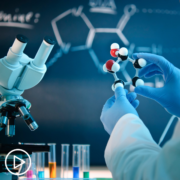
|
Transcript:
Katherine Banwell:
Let’s talk about this new groundbreaking menin inhibitor therapy. Can you go into more detail about what the therapy is and who it might be right for?
Dr. Sanam Loghavi:
Sure. So, right now, the drug really has been tested in the setting of relapsed refractory disease, meaning for patients whose disease has already been treated but has relapsed. And there are certain genetic subtypes of acute myeloid leukemia that are eligible for this disease, or unamenable, sorry, to this targeted therapy. So, these include acute myeloid leukemias with NPM1 mutation or acute myeloid leukemias with KMT2A, or formerly known as the MLL gene-rearrangement.
And the reason for this that these alterations, these genetic alterations lead to an apparent interaction of menin with KMT2A and the leukemia depends on this interaction. So, what the Menin inhibitor does, it eliminates this interaction and so it’s used for therapy in patients that have this genetic change.
Katherine Banwell:
Are there other menin inhibitors in development?
Dr. Sanam Loghavi:
There are.
Katherine Banwell:
And what are they?
Dr. Sanam Loghavi:
There are several specific ones that are being tested of different names. So, the one that MD Anderson just published on is revumenib, but there are several ones that are in development.
Katherine Banwell:
And what about these other inhibitors are showing promise?
Dr. Sanam Loghavi:
So, if you think about AML, in general, really the only curative therapy that we have, outside of the favorable risk disease, is hematopoietic stem cell transplant.
And hematopoietic stem cell transplant is not a trivial treatment, it has a lot of side effects in and of itself. So, the goal really is to be able to treat patients with less intensive therapies. And the goal of these targeted therapies is to provide patients with less intensive therapies even compared with chemotherapy, with conventional chemotherapy that tends to be toxic. So, the goal is really to be smart about it and try to figure out how the pathogenesis of disease is developed and to try and eliminate the pathways that that cancer is using to proliferate.
Katherine Banwell:
If patients are interested in this menin inhibitor therapy, where do they start? Are there trials outside of MD Anderson?
Dr. Sanam Loghavi:
Yes. These are multi-institutional trials, and I will tell you that the best resource to identify clinical trials is essentially clinicaltrials.gov, dot G-O-V. So, you can go there and look up the active clinical trials by disease type, by location. So, that is the best resource to identify clinical trials.
Why Is the Menin Pathway Important in AML?
Why Is the Menin Pathway Important in AML? from Patient Empowerment Network on Vimeo.
What should acute myeloid leukemia (AML) patients know about the menin pathway? Dr. Naval Daver from the University of Texas MD Anderson Cancer Center shares information from ASH 2022. .Learn research updates about the menin pathway and ongoing clinical trials on the pathway.
[ACT]IVATION TIP from Dr. Daver: “Patients should be checked for arrangements like MLL rearrangement NPM1 mutation, new fusions as these may be amenable to therapy with the menin inhibitors, there are multiple trials with five different menin inhibitors, single agent trials and also combination trials now ongoing across multiple centers both in the U.S. and ex-U.S.“
Download Resource Guide en español
Related Resources:

What Are Some Clinical Predictors for Relapse in Acute Myeloid Leukemia? |
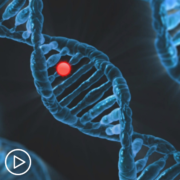
|

|
Transcript:
Art:
Dr. Daver, what is a menin pathway in AML? And why is it significant?
Dr. Naval Daver:
The menin pathway is very recently discussed that way, the pathway, of course, itself has been known for almost a decade, this is an epigenetic pathway, and in certain subsets of AML such as MLL rearranged NPM1 mutated as well as other fusions, we find that there is an up regulation of the menin impact rearrangement, and this actually results in increased production of two enzymes called meis-1 and hox-DNA) these enzymes actually result in a differentiation blockade. So normally, in the bone marrow we have the early progenitor cells, this then leads to be a report cell and leads to mature neutrophils and monocytes and blood cells, but in a differentiation blockade, we would see that those cells over time would start generating mutations and become leukemic cells.
So one of the most physiological ways to treat AML is to actually remove the differentiation blockade, so the normal process of differentiation with progress, and so these menin inhibitors are able to reduce the levels of MEIS1 and HOXA by doing this, they allow the normal differentiation cascade to progress, and they’re not cytotoxic targeted chemo, they’re not directly killing leukemia, but they’re actually allowing the leukemia itself to then mature to no monocytes and neutrophils.
And so now there are five different menin inhibitors in ongoing clinical trials, but two of these are more advanced and have shown data recently in the ASH 2022 meeting the newer drugs, and are showing close to 40 to 50 percent single agent efficacy, and we believe that after the FLT3, IDH1, IDH2 inhibitors, which have been approved in the last five years, the menin inhibitors are probably the next other targeted therapies that will hopefully get approval and they eventually be used in the frontline setting in combination approaches.
The activation tip related to this question is that patients should be checked for arrangements like MLL rearrangement NPM1 mutation, new fusions as these may be amenable to therapy with the menin inhibitors, there are multiple trials with five different menin inhibitors, single agent trials and also combination trials now ongoing across multiple centers both in the U.S. and ex-U.S., and if one does have an aberration that will be sensitive to such menin inhibitor-based therapy, I would strongly recommend considering trying to get on one of those trials because we believe that these will be the best outcomes with such standard therapies rather than using the standard or traditional chemotherapies.
Share Your Feedback About [ACT]IVATED AML
How Does the Presence of Molecular Markers Affect AML Care?
How Does the Presence of Molecular Markers Affect AML Care? from Patient Empowerment Network on Vimeo.
Dr. Farhad Ravandi-Kashani reviews how the presence of gene mutations can influence acute myeloid leukemia (AML) treatment choices and discusses new molecular markers being researched for future AML care.
Dr. Farhad Ravandi-Kashani is professor of medicine and Chief of the Section of Developmental Therapeutics in the Department of Leukemia at The University of Texas MD Anderson Cancer Center in Houston, TX. Learn more about Dr. Ravandi-Kashani.
Related Resources:
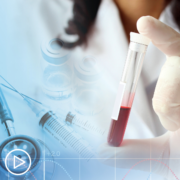
|

|

|
Transcript:
Laura Beth:
How do test results impact AML care and treatment decisions?
Dr. Ravandi:
So, in the first place, the presence or absence of certain mutations can be predictable outcome. Some subsets of leukemias are, for the lack of a better term, more favorable.
I personally don’t think there is anything favorable about any leukemia, but some are easier to treat, and some are easier to cure than others. There is one specific subtype called acute promyelocytic leukemia that we actually completely treat differently. We don’t use even chemotherapy in that subset of leukemia.
It has almost 100 percent success rate. And the treatment of other subsets can also be tailored, depending on these molecular and chromosomal changes. So, the initial therapy can be actually changed. There are now, for example, targeted agents that can be added to the chemotherapy, during initial chemotherapy.
And also, once the patient is in remission, depending on favorable or unfavorable their leukemia is, they may be offered allogeneic stem cell transplant. So, yes, this information is highly important. In fact, I would say crucial for our decision-making in leukemia therapy these days.
Laura Beth:
So, what is new in AML research related to molecular markers?
Dr. Ravandi:
Well, it depends on your definition of new, but FLT3 mutations are very important because they’re now several FLT3 inhibitors, and as I mentioned, the initial therapies are different, to some extent. The IDH mutations are very important, again, because they are specific targeted agents.
TP53 mutations are important because, unfortunately, they are particularly unfavorable.
This is completely hot off the press, but there are subsets of AML called MLL rearranged leukemias that can respond to these drugs called Menin inhibitors.
There are other mutations that have been discovered, many other ones, that there are no specific treatments for at the moment, but there’s a lot of research on.
Which Tests Do You Need Before Deciding on an AML Treatment Path?
Which Tests Do You Need Before Deciding on an AML Treatment Path? from Patient Empowerment Network on Vimeo.
Why is it important to ask about biomarker testing for your AML? Find out how test results could reveal more about your AML and may help determine the most effective treatment approach for your individual disease.
Related Resources:

|

|

|
Transcript:
Why do you need biomarker testing before deciding on a treatment plan for your acute myeloid leukemia—also known as AML?
The results may predict how your AML will behave and could indicate that one type of treatment may be more effective than another.
Biomarker testing—also referred to as risk stratification, genetic testing, or molecular testing—identifies specific gene mutations, proteins, chromosomal abnormalities and/or other molecular changes that are unique to your AML.
The results of these tests are used to determine if you have low-risk or high-risk AML to help guide prognosis and to evaluate the goals of treatment.
There are certain biomarkers—such as the FLT3, IDH1 and IDH2 mutations—that could indicate that your AML may respond well to a targeted therapy. There are several FDA-approved targeted therapies—known as inhibitor therapies—which treat patients with these mutations.
Additionally, the identification of other biomarkers—such as TP53, NPM1, or CEBPA mutations, to name a few—may aid in assessing your prognosis, determining a treatment course, or may identify if an allogeneic stem cell transplant may be appropriate. Results of these tests may also suggest that a clinical trial is your best treatment option.
So, how can you Insist on the best care for YOUR AML?
• First, always bring a friend or a loved one to your appointments to help you process information and to take notes.
• Ask your doctor if you have had, or will receive, biomarker testing and how the results may impact your care and treatment plan. Be sure to ask for paper or electronic copies of your important test results.
• Finally, always speak up and ask questions. It’s important that you understand all of the information that you want to know about your AML to help make the best treatment decisions for you. You are your own best advocate, and treating AML is a team approach.
To learn more about your AML and to access tools for self-advocacy, visit powerfulpatients.org/AML.
AML Targeted Therapies, What’s Available and How Do They Work?
AML Targeted Therapies, What’s Available and How Do They Work? from Patient Empowerment Network on Vimeo.
There are several targeted therapies approved for the treatment of acute myeloid leukemia (AML). Expert Dr. Ellen Ritchie provides insight about recent approvals, how these therapies work, and shares details about newer therapies currently being studied for the treatment of AML.
Dr. Ellen K. Ritchie is assistant professor of medicine and a member of the Leukemia Program at the Weill Cornell Medical College of Cornell University and the New York Presbyterian Hospital. More about Dr. Ritchie, here.
Related Resources:

|

|
Transcript:
Katherine:
You touched upon this earlier, but what targeted therapies or treatments are available for AML patients?
Dr. Ritchie:
So, there have been many recent FDA approvals of drugs that are targeted. One, is the FLT3 inhibitors. And the two that are available are Midostaurin, which is most commonly – was the first drug that was really added to intensive chemotherapy.
And clinical trials show that in those FLT3-positive population that patients had an overall better outcome if midostaurin (Rydapt) were added to intensive chemotherapy. There’s also a drug called gilteritinib (Xospata), and this drug is also a FLT3 inhibitor that was tested in patients who had refractory leukemia. They could either get real chemotherapy regimen or they could get gilteritinib. And it turns out in the FLT3-positive patients, the gilteritinib was superior to the strong chemotherapy. So that’s been approved for patients who have refractory, or disease that didn’t really respond to initial therapy, that is IDH – or is FLT3-positive.
Then there’s the IDH1 and IDH2 inhibitors that have also been approved, and a small proportion of AML patients will be positive for IDH1 or IDH2 mutations.
The IDH1 inhibitor ivosidenib (Tibsovo), is available and can be used to treat patients if you know up front, they have an IDH1 inhibitor. So, that’s a regimen where the single agent can be used to treat an IDH1 mutated patient who’s newly diagnosed. Those patients are also eligible for many clinical trials now, where they’re combining that particular drug with other agents, in an effort to improve outcome. For IDH2 positive patients, there’s a drug called enasidenib (Idhifa). And this drug is used mainly in patients in the second line setting. But it specifically targets IDH2. And patients go into remission sometimes for a prolonged period of time. So, these drugs are FDA approved, and they’re treating targetable mutations.
TP53 mutations are a particularly bothersome mutation because it confers a poor outcome. And I’m happy to say that we have clinical trials now that are available that actually target TP53 mutations.
So, there are – there is therapy available for that type of mutation that was
not available before through the clinical trials. And I expect in coming years that we’re going to see more and more targeted therapies develop in AML which can be used potentially in combination with what we’re already using as backbones to enhance the outcome of patients with this disease.
Katherine:
Well, how do targeted therapies work?
Dr. Ritchie:
So, targeted therapies work on – it’s sort of complicated. The targets which are available, IDH or the FLT3 is really on the outside of the cell and it is a drug which is targeted directly to the FLT3 on the outside of the cell.
It works quite well in the peripheral blood, where you see the blast oftentimes disappear. The big concern always is how well it’s working getting deep into the marrow. But it’s looking at the target on the outside of the cell. IDH1 and IDH2 inhibitors work on particular chemicals which are involved in the kreb cycle, and those of you that took high school chemistry may have memories buried in the deep parts of your brain of learning the kreb cycle. And this is a fundamental metabolic cycle inside cells, and if you have a mutation, an IDH1 or IDH2, you’re unable to go through that full kreb cycle in the appropriate way. And that is something that leads to you having a cancer, in this case AML. So, these drugs actually interfere with what’s happening in that kreb cycle, and allow you to make more normal cells.
Factors to Consider When Choosing an AML Treatment
Factors to Consider When Choosing an AML Treatment from Patient Empowerment Network on Vimeo.
What test results and factors should be considered when choosing an acute myeloid leukemia (AML) treatment? Expert Dr. Ellen Ritchie explains how test results impact AML prognosis and treatment – and other factors that come into play when determining a treatment approach.
Dr. Ellen K. Ritchie is assistant professor of medicine and a member of the Leukemia Program at the Weill Cornell Medical College of Cornell University and the New York Presbyterian Hospital. More about Dr. Ritchie, here.
Related Resources:

|
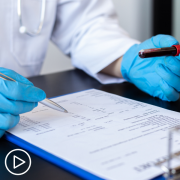
|

|
Transcript:
Katherine:
How do the results of these tests affect prognosis and treatment?
Dr. Ritchie:
Well, when a patient has AML, if they are a fit patient, if it will help us determine after initial induction, whether to cure the patient we need to do a bone marrow transplant, or we can just continue with chemotherapy.
And those are really important things to determine. So, if you have a good prognosis AML, if you have an AML that has certain translocations like inversion 16 or 821, or if you have a CEPBA mutation or you have an NPM1 mutation, and that’s all you have, you may do particularly well with chemotherapy treatment alone. And you won’t need to have a bone marrow transplant.
If you have certain other mutations, we know that the only way that we’re going to cure you, is with a bone marrow transplant. And if you are fit, when we finish induction and even as we’re doing induction, we’re preparing you for a bone marrow transplant down the line.
One disadvantage, just to mention about the molecular testing, is it doesn’t come back as quickly as some of the other testing. So that you will have already started induction chemotherapy most generally before the mutational testing comes back. Which can be anywhere – depending upon the institution, between seven and 21 days. So, it takes time for those results to be available.
Katherine:
Outside of test results, Dr. Ritchie, what other factors should be considered when choosing treatment?
Dr. Ritchie:
So, you want to choose whether a patient is most likely to benefit from intense induction chemotherapy. With strong chemotherapies where the backbone of those therapies would be an anthracycline, like daunorubicin (Cerubidine) or cytarabine (Liposomal), or daunorubicin or idarubicin (Idamycin PFS), together with cytarabine. And these are intensive chemotherapies. Versus, non-intensive chemotherapy which is able to be done as an outpatient, more frequently. And it is something that is gentler for a patient, they’re less likely to have severe toxicity. And the backbone of those regimens is using a drug called azacitidine (Vidaza) or decitabine (Inqovi), together with a second drug called venetoclax (Venclexta).
So, these are the two backbones, there may be clinical trials or there may be targetable aspects of your leukemia, which drugs would be added to either of those backbones. But those are the two backbones. And I also like to identify those patients that may not benefit from chemotherapy at all. And so, it’s very important, I think to really get to know your patient. And I spend time with my patient, particularly on the first visit, to understand not only their physical health, but their mental health. How good is their cognition, what is their mood, are they depressed, or are they happy people? And what is their circumstance? Do they have people to support them? Do they live close to family? Is a caregiver able to come, with an elderly patient for example, to visits?
Those, and whether or not they’re living alone and need tremendous support. So that’s really important to determine and helps me to choose what the best therapy might be. And also, concurrently what I can do to shore up the patient to do better with whatever therapy that I’m giving them. I.e., if you’re depressed, let’s work on that, or if your blood pressure is too high, or if you are – your diabetes is out of control at the same time that I’m seeing you, to try and fix those particular problems. In older patients I often do sort of a miniature version of the geriatric assessment. And in trials that have been so far, the most important aspects of the geriatric assessment, are really what is your cognitive function? Do have a mild dementia, or do you not have a mild dementia? Because dementia may be or mild dementia may be associated with poorer outcome.
The other is, are you able to do what we call the incidental tasks of daily life. So, you know fundamental tasks are really brushing your teeth and combing your hair, and dressing yourself. But are you able to do your cooking and your shopping and your banking and those things? Patients who have trouble doing their cooking and shopping and banking, and those types of activities, that also has been associated with a poor overall survival in AML. So, it’s really important to determine all of those aspects and if there are any deficiencies, to really know that the only therapeutic choice for that particular patient would be a low-intensity therapy.
Understanding Personalized Medicine for AML
Understanding Personalized Medicine for AML from Patient Empowerment Network on Vimeo.
What should you know before deciding on treatment for YOUR AML? AML specialist Dr. Ellen Ritchie reviews key factors that guide treatment choices, including biomarker testing results, and shares advice for partnering with your team to advocate for the best care.
Dr. Ellen K. Ritchie is assistant professor of medicine and a member of the Leukemia Program at the Weill Cornell Medical College of Cornell University and the New York Presbyterian Hospital. More about Dr. Ritchie, here.
Related Resources:
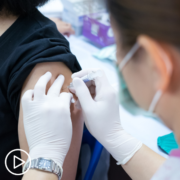
|

|
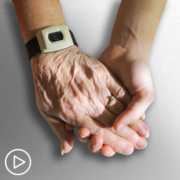
|
Transcript:
Katherine:
As we begin to talk about personalized therapy and AML, let’s start with the basics. How would you define personalized medicine?
Dr. Ritchie:
Personalized medicine, to me is really, it’s a difficult question. It’s trying to find the best treatment for a particular patient. And it’s looking at biologic issues, what kind of cancer, what type of AML is it, what are the specific mutations or chromosomal abnormalities. But it’s also looking at the person. Is the patient active or not active? Do they have lots of other diseases like diabetes and coronary artery disease? Or pulmonary disease, or are they completely healthy?
Or, do they have support at home? If they’re sick at home is there someone who can take care of them, versus a situation where you’re older and alone and you have no real family member to rely on. So, all of these things are very important in making a personalized decision as to how you treat a patient.
Which AML Treatment Is Right for You? What You Need to Know
Which AML Treatment Is Right for You? What You Need to Know from Patient Empowerment Network on Vimeo.
What should you know before deciding which treatment is best for YOUR AML? AML specialist Dr. Ellen Ritchie reviews key factors that guide treatment choices, including biomarker testing results, and shares advice for partnering with your team to advocate for the best care.
Dr. Ellen K. Ritchie is assistant professor of medicine and a member of the Leukemia Program at the Weill Cornell Medical College of Cornell University and the New York Presbyterian Hospital. More about Dr. Ritchie, here: weillcornell.org/ekritchie.
Related Resources:

|

Expert Advice for AML Patients When Making Treatment Choices |

|
Transcript:
Katherine:
Hello, and welcome. I’m Katherine Banwell, your host for today’s program. Today we’re going to discuss how to access the most personalized AML therapy for your individual disease, and why it’s essential to insist on key testing. Before we meet our guest, let’s review a few important details. The reminder email you received about this program, contains a link to program materials. If you haven’t already, click that link to access information to follow along during this webinar.
Finally, please remember that this program is not a substitute for seeking medical advice. Please refer to your healthcare team about what might be best for you. All right, let’s meet our guest today. Joining me is Dr. Ellen Ritchie. Dr. Ritchie, would you please introduce yourself?
Dr. Ritchie:
Hello, my name is Dr. Ellen Ritchie, and I am an attending with a Leukemia service, and an assistant director since, for the last 15 years.
And I treat mainly Acute Myeloid Leukemia, Myelodysplastic syndromes, which are kind of a pre-Leukemia; and Myeloproliferative diseases. And have a particular interest in the treatment of older patients with AML.
Katherine:
Excellent, well thank you so much for joining us today. As we begin to talk about personalized therapy and AML, let’s start with the basics. How would you define personalized medicine?
Dr. Ritchie:
Personalized medicine, to me is really, it’s a difficult question. It’s trying to find the best treatment for a particular patient. And it’s looking at biologic issues, what kind of cancer, what type of AML is it, what are the specific mutations or chromosomal abnormalities. But it’s also looking at the person. Is the patient active or not active? Do they have lots of other diseases like diabetes and coronary artery disease? Or pulmonary disease, or are they completely healthy?
Or, do they have support at home? If they’re sick at home is there someone who can take care of them, versus a situation where you’re older and alone and you have no real family member to rely on. So, all of these things are very important in making a personalized decision as to how you treat a patient.
Katherine:
Well, it sounds like, each person’s AML is unique. So, let’s help our audience be clear about basic testing. What tests are necessary to help understand a patient’s specific disease at diagnosis?
Dr. Ritchie:
I mean certainly it’s important to do a physical exam and to find out what the general health of the patient is. In order to evaluate an AML, or any other Leukemia, I look at the peripheral blood smear. To look at what I think the type of Leukemia might be that I am dealing with. There are some Leukemias that have particular way that they look like Acute Promyelocytic Leukemia for which there is a designated therapy which works.
And you can tell that just by looking at a peripheral blood slide. The next test is always a bone marrow biopsy. Patients are not delighted that that is a test, but it is a test that can be done in the office, usually within 15 to 20 minutes. And that test gives us a lot of information. It gives us information about what type of AML it is, what are the markers on the outside of the cell, it gives us information about the chromosomes inside the Leukemia cell. Are there missing chromosomes, or rearranged chromosomes? And if there are, that can be very relevant to the prognosis. And lastly, it’s sent for a particular mutations or markers. So, we look for IDH3 mutations, we look for FLT3 mutations, we look for IDH1 and IDH2 mutations, and we do an entire myeloid panel. Which is about 44/45 genes that are most commonly mutated in patients with AML.
So that’s the initial work up for any AML patient.
Katherine:
You mentioned markers Dr. Ritchie. What is genomic, or bio marker testing?
Dr. Ritchie:
So, we’re looking really at most specifically at mutations inside individual genes that might be in your Leukemia cell. So, there are some mutations actually that confer a better prognosis. Like NPM1 or CEPBA, those can be more positive type of prognosis than some of the others.
But we’re also looking for markers that might be targetable with certain therapies that we have. So, if you have a FLT3 ITD or TKD, we actually have particular drugs which can target those particular mutations. There are also drugs that are FDA approved to treat IDH1 and IDH2 mutations.
There are certain mutations that have a relatively poor prognosis, like TP53 for which there are clinical trials which are available, which specifically are meant to target patients who have those sorts of mutations. And there’re other clinical trials using the FDA approved drugs that I just mentioned, for FLT3, for IDH1 and IDH2 and combining it with other agents to try and improve outcome in AML patients.
Katherine:
Some patients may not know if they’ve received these important tests, so what key questions should they be asking their physician about testing?
Dr. Ritchie:
So, physicians, they – financial coverage of the mutational testing is not uniform across the country and across insurances. So, Medicare and different Medicare insurances and some of the private insurances all vary in their coverage.
So, in my clinic, I am asking – I prefer the test that we do in house at Cornell. But it’s important that I ask, what will their insurance cover. And make sure that I send the appropriate testing that will be covered by insurance. There are some insurances that will not cover this type of testing. So, it is a real question for the patient, when you go to see the doctor to say, are you going to do mutational NGS testing?
And, will my insurance cover this? Hopefully most – if Medicare adopts the coverage of these types of mutational testing, it’s often true that private insurance will eventually pick this up. But it’s a murky field and it’s really important to talk to your doctor about this. The cost of the bone marrow biopsy, and the chromosomal evaluation is nearly always covered by insurance.
Katherine:
Okay, that’s really great advice, thank you. How do the results of these tests affect prognosis and treatment?
Dr. Ritchie:
Well, when a patient has AML, if they are a fit patient, if it will help us determine after initial induction, whether to cure the patient we need to do a bone marrow transplant, or we can just continue with chemotherapy.
And those are really important things to determine. So, if you have a good prognosis AML, if you have an AML that has certain translocations like inversion 16 or 821, or if you have a CEPBA mutation or you have an NPM1 mutation, and that’s all you have, you may do particularly well with chemotherapy treatment alone. And you won’t need to have a bone marrow transplant.
If you have certain other mutations, we know that the only way that we’re going to cure you, is with a bone marrow transplant. And if you are fit, when we finish induction and even as we’re doing induction, we’re preparing you for a bone marrow transplant down the line.
One disadvantage, just to mention about the molecular testing, is it doesn’t come back as quickly as some of the other testing. So that you will have already started induction chemotherapy most generally before the mutational testing comes back. Which can be anywhere – depending upon the institution, between seven and 21 days. So, it takes time for those results to be available.
Katherine:
Outside of test results Dr. Ritchie, what other factors should be considered when choosing treatment?
Dr. Ritchie:
So, you want to choose whether a patient is most likely to benefit from intense induction chemotherapy. With strong chemotherapies where the backbone of those therapies would be an anthracycline, like Daunorubicin or Cytarabine, or Daunorubicin or Idarubicin, together with Cytarabine. And these are intensive chemotherapies. Versus, non-intensive chemotherapy which is able to be done as an outpatient, more frequently. And it is something that is gentler for a patient, they’re less likely to have severe toxicity. And the backbone of those regimens is using a drug called Azacitidine or Decitabine, together with a second drug called Venetoclax.
So, these are the two backbones, there may be clinical trials or there may be targetable aspects of your Leukemia, which drugs would be added to either of those backbones. But those are the two backbones. And I also like to identify those patients that may not benefit from chemotherapy at all. And so, it’s very important, I think to really get to know your patient. And I spend time with my patient, particularly on the first visit, to understand not only their physical health, but their mental health. How good is their cognition, what is their mood, are they depressed, or are they happy people? And what is their circumstance? Do they have people to support them? Do they live close to family? Is a caregiver able to come, with an elderly patient for example, to visits?
Those, and whether or not they’re living alone and need tremendous support. So that’s really important to determine and helps me to choose what the best therapy might be. And also, concurrently what I can do to shore up the patient to do better with whatever therapy that I’m giving them. I.E., if you’re depressed, let’s work on that, or if your blood pressure is too high, or if you are – your diabetes is out of control at the same time that I’m seeing you, to try and fix those particular problems. In older patients I often do sort of a miniature version of the geriatric assessment. And in trials that have been so far, the most important aspects of the geriatric assessment, are really what is your cognitive function? Do have a mild dementia or do you not have a mild dementia? Because dementia may be or mild dementia may be associated with poorer outcome.
The other is, are you able to do what we call the incidental tasks of daily life. So, you know fundamental tasks are really brushing your teeth and combing your hair, and dressing yourself. But are you able to do your cooking and your shopping and your banking and those things? Patients who have trouble doing their cooking and shopping and banking, and those types of activities, that also has been associated with a poor overall survival in AML. So, it’s really important to determine all of those aspects and if there are any deficiencies, to really know that the only therapeutic choice for that particular patient would be a low-intensity therapy.
Katherine:
You touched upon this earlier, but what targeted therapies or treatments are available for AML patients?
Dr. Ritchie:
So, there have been many recent FDA approvals of drugs that are targeted. One, is the FLT3 inhibitors. And the two that are available are Midostaurin, which is most commonly – was the first drug that was really added to intensive chemotherapy.
And clinical trials show that in those FLT3 positive population that patients had an overall better outcome if Midostaurin were added to intensive chemotherapy. There’s also a drug called gilteritinib, and this drug is also a FLT3 inhibitor that was tested in patients who had refractory leukemia. They could either get real chemotherapy regimen or they could get gilteritinib. And it turns out in the FLT3-positive patients, the gilteritinib was superior to the strong chemotherapy. So that’s been approved for patients who have refractory, or disease that didn’t really respond to initial therapy, that is IDH – or is FLT3 positive.
Then there’s the IDH1 and IDH2 inhibitors that have also been approved, and a small proportion of AML patients will be positive for IDH1 or IDH2 mutations.
The IDH1 inhibitor Ivosidenib, is available and can be used to treat patients if you know up front, they have an IDH1 inhibitor. So, that’s a regimen where the single agent can be used to treat an IDH1 mutated patient who’s newly diagnosed. Those patients are also eligible for many clinical trials now, where they’re combining that particular drug with other agents, in an effort to improve outcome. For IDH2 positive patients, there’s a drug called Enasidenib. And this drug is used mainly in patients in the second line setting. But it specifically targets IDH2. And patients go into remission sometimes for a prolonged period of time. So, these drugs are FDA approved, and they’re treating targetable mutations.
TP53 mutations are a particularly bothersome mutation because it confers a poor outcome. And I’m happy to say that we have clinical trials now that are available that actually target TP53 mutations.
So, there are – there is therapy available for that type of mutation that was not available before through the clinical trials. And I expect in coming years that we’re gonna see more and more targeted therapies develop in AML which can be used potentially in combination with what we’re already using as backbones to enhance the outcome of patients with this disease.
Katherine:
Well, how do targeted therapies work?
Dr. Ritchie:
So, targeted therapies work on – it’s sort of complicated. The targets which are available, IDH or the FLT3 is really on the outside of the cell and it is a drug which is targeted directly to the FLT3 on the outside of the cell.
It works quite well in the peripheral blood, where you see the blast oftentimes disappear. The big concern always is how well it’s working getting deep into the marrow. But it’s looking at the target on the outside of the cell. IDH1 and IDH2 inhibitors work on particular chemicals which are involved in the kreb cycle, and those of you that took high school chemistry may have memories buried in the deep parts of your brain of learning the kreb cycle. And this is a fundamental metabolic cycle inside cells, and if you have a mutation, an IDH1 or IDH2, you’re unable to go through that full kreb cycle in the appropriate way. And that is something that leads to you having a cancer, in this case AML. So, these drugs actually interfere with what’s happening in that kreb cycle, and allow you to make more normal cells.
Katherine:
You mentioned earlier Dr. Ritchie, low-intensity therapy. Could you tell us about the types of treatment options?
Dr. Ritchie:
So, I’ll go – high-intensity therapy or intense chemotherapy always has to be given really in a hospital. And if you don’t start it – if you can start certain intensive chemotherapies, like Vyxeos, which is also intensive, in the outpatient setting, but by day seven or eight, you end up in the hospital. And in intensive chemotherapies, you lose your hair, there’s GI toxicities, you’re at high risk of developing infections and you need a lot of transfusion. And for even young people, it’s a difficult therapy for which you’re in the hospital, and 90-some percent of patients are on IV antibiotics.
So, it’s intensive chemotherapy because it has to be given in a hospital setting and requires intensive supportive care. Low-intensity therapy can be given in the outpatient setting. So, at the present time you can get a drug like Azacitidine, for example, which is an injection that you get seven days in a row. Unfortunately, you have to come to the doctor’s office every day for those injections, but once you’ve had the injection, you can go home. Combined with Venetoclax which is an oral agent. So, an oral agent can be given at home. You need close supervision in the physician’s office when you’re on this type of therapy, but you don’t need the constant support that you need if you are getting intensive chemotherapy. So, it can be done, in the comfort really of your home and with your family. You will have to come in and have transfusions potentially as an outpatient, nearly everyone does. And there’s always the risk that you develop a fever and if you do, you have to come into the hospital for IV antibiotics.
But in general, low-intensity means not so much support needed in a hospitalized setting, and the tolerability of this particular chemotherapy in the outpatient setting.
Katherine:
Once a patient has begun treatment, how do you monitor whether it’s working?
Dr. Ritchie:
So, one of the more frustrating things about being an AML patient, is you don’t know right off the bat whether or not that you have gone into remission. So, what happens is you receive the chemotherapy, and the day you start chemotherapy is really day one. And somewhere around day 14, you’re at your lowest point. So, your blood counts are low, and you often feel really terrible, and you really wonder, is this working? But unfortunately, I can’t really tell you. Some institutions do bone marrow biopsies if you have intensive chemotherapy on day 14, or if you’re getting Venetoclax therapy somewhere around day 21 to look and see whether they still see Leukemia cells, but the utility of that is different per institution.
The real test of whether chemotherapy x`, is at the end of about 28-35 days, are your blood counts coming up, and are you making normal blood cells. Are you making platelets, which are the part of the blood that clots the blood? Or are you making neutrophils, which are the important cells needed to help you fight infection. So, the real proof of a remission, is are your platelets over 100,000? Is your neutrophil count over 1,000? And when we look in the bone marrow around that time, do we see normal cells developing and no Leukemia?
Katherine:
How often should testing take place? And should patients be retested over time?
Dr. Ritchie:
So, the bone marrow biopsy is done frequently once you have a diagnosis of Acute Leukemia. So certainly, it’s done upon diagnosis of the disease.
And as I mentioned earlier in certain institutions, about halfway through your chemotherapy cycle, they’ll do a bone marrow biopsy to see whether or not they see any residual Leukemia cells. That’s not done everywhere, and it’s done differently depending upon institutions sometimes. At the end of the chemotherapy treatment, if you recover your blood counts, we do a bone marrow biopsy to confirm a remission. If by day 35, we haven’t seen that your blood counts are recovering, we may do a bone marrow biopsy to see whether or not we see Leukemia cells in there, or early recovery. So, you’re definitely going to have bone marrows at those time points. If you’ve gone into remission, it depends on what we’d do next as to when you would have another bone marrow biopsy. So, if you’re going to bone marrow transplant you may have one more biopsy, just prior to going into transplant, and another biopsy at the end of the first month after transplant.
If you’re gonna have what we call ongoing therapy, roughly every three or four months, we may do a bone marrow biopsy to determine whether or not the remission is holding. If during ongoing therapy, we see that there is blood count abnormalities that we weren’t expecting, that might be a reason that we would do a bone marrow biopsy. And that’s unpredictable as to when that would be.
Katherine:
Dr. Ritchie, what advice do you have for patients to help them feel more confident in speaking up and advocating, being a partner in their care?
Dr. Ritchie:
Well, when you choose a Leukemia doctor, you need to choose someone that you can actually communicate with. Someone who you feel is not allowing you to ask questions, or is not curious about what your life is like, you may wanna think, I wanna check out somebody else.
Because it’s really important you like the person who’s your doctor, and that you have a trust relationship together. So, it’s really – I tell some patients it’s a marriage of convenience that we have. And that you really have to think of it that way. If someone doesn’t allow you to ask questions or if they are not fully answering your questions in a way that you understand, try and speak up for yourself and make sure that the doctor tries to address that. And if the doctor won’t address those things for you, or you feel like you don’t understand what is being explained to you, then you can think about trying to see someone else. I think it’s really important if you can, to write down as many questions as you have about your disease before you come in.
Because often what happens is you get there, you’re stunned by the amount of information, and the questions you wanted to ask, you forget. And the next day, you’re like, ugh, I didn’t ask these questions. So, before you come in, if you write questions. Questions about insurance coverage, that may not be something that we go over. Or questions about toxicities, or questions, if I’m gonna lose my hair, do you have the name of a wig facility. All these questions that you might have, put them on a piece of paper, so that they can be addressed when you’re with the doctor. And other things will come up, you’ll have other questions when you’re there, but make sure your fundamental questions are answered.
Katherine:
Yeah, those are great suggestions. We have a couple of audience questions. Mike wants to know, what does it mean to have high-risk AML?
Dr. Ritchie:
High-risk AML means that there is something in your chromosomes that are worrisome and may confer a worse outcome. Or that one of the mutations that you have, or the combination of mutations that you have and the genetic testing are poor risk mutations that are associated with poor outcome. So, high-risk, really means a high risk of progression, or a high risk of – it’s a high risk of not going into remission and not being treatable AML. So, these are AMLs we treat aggressively, and if we get a patient into remission, we generally send high-risk patients to a bone marrow transplant.
Katherine:
The second question is from Craig, he says; I’m currently undergoing treatment for AML, is the Covid-19 vaccine safe and effective?
Dr. Ritchie:
I recommend the Covid-19 vaccine to everyone, all my patients. A little immunity is better than none. And there is preliminary data, looking at patients with Myeloid malignancies, not Lymphoid, but Myeloid malignancies, where it appears there is an immune response to the Covid-19 vaccine. So, I would suggest that you get the Covid-19 vaccine. Any of them that are available, are good. Whether it’s Moderna, or Pfizer, or Johnson and Johnson. Whatever is available to you, you should go ahead and get.
Katherine:
Are there any symptoms or issues that AML patients should be looking for post-vaccine?
Dr. Ritchie:
Post-vaccine, there’s a lot of symptoms that people have. And they can be similar among Myeloid patients. Some of my patients have had no reaction whatsoever, some people have had a really sore arm.
Some patients are incredibly tired after the vaccine; some patients develop a low-grade fever for a couple of days. Those are really what we watch for. Sometimes when there’s a reaction, we’re hopeful that there’s an antibody being made, or an immune response that’s developing. So, it’s not always a bad thing if you have a reaction. But I don’t think that the reactions of patients of Myeloid malignancies is any different than that of the general public.
Katherine:
That’s what it sounds like. To close Dr. Ritchie, what would you like to leave the audience with? Are you hopeful about the future of AML treatment?
Dr. Ritchie:
I’m very hopeful. I’ve worked in this field for 15 years and through the 15 years we have seen a lot of new drugs that have been approved for AML. It’s remarkable, the FLT3 inhibitors, IDH1 and IDH2 inhibitors, new formulations of intensive chemotherapy, like Vyxeos, the Pfizer drug; glasdegib – I can never say that one. And most importantly, venetoclax, which has really revolutionized our treatment of low-risk, or not low-risk, but the low intensity patient.
I see in the future that there is gonna be more – there’s an emphasis on immunotherapy, so I think we’re gonna see more antibody-based therapy that’s going to be approved by the FDA. Maybe it will be used in combination with the drugs that we are already using. There are all sorts of combinations using all the FDA approved drugs in different ways together. So, we can maybe do better with the drugs that we have. And there’s always new targeted drugs which are being tested in AML. So, I think as time goes on, from a molecular perspective it will be even more targeted. And I’m hoping also that there will be oral formulations of a lot of our drugs. So, it’s kind of exciting that there’s an oral form of Decitabine called Inqovi, which is something that could potentially be given in induction therapy right off the bat with Venetoclax for an all-oral regimen at home.
All of these things are great advances, in my opinion, and I think that the opportunity to treat patients outside the hospital, with more targeted therapy and immunotherapy is gonna be the future.
Katherine:
Yeah. And the future sounds promising. Thank you so much for joining us today Dr. Ritchie.
Dr. Ritchie:
Thank you for having me.
Katherine:
And thank you to all of our partners.
To learn more about AML, and to access tools to help you become a proactive patient, visit powerfulpatients.org. I’m Katherine Banwell, thanks for joining us.
Treatment Approaches in AML: Key Testing for Personalized Care
When it comes to Acute Myeloid Leukemia (AML), genetic testing (or biomarker testing) is essential in helping to determine the best treatment approach for YOU. In this program, AML expert, Dr. Naval Daver reviews key decision-making factors, current AML treatments and emerging research for patients with AML.
About the Guest:
Dr. Naval Daver is an Associate Professor in the Department of Leukemia at The University of Texas MD Anderson Cancer Center. More about Dr. Daver: https://faculty.mdanderson.org/profiles/naval_daver.html
How Will I Know if My AML Treatment is Working?
How Will I Know if My AML Treatment is Working? from Patient Empowerment Network on Vimeo.
During acute myeloid leukemia (AML) treatment, specific tests help to gauge a patient’s treatment response. Dr. Pinkal Desai details how diagnostic tests are used in monitoring the efficacy of an AML therapy
Dr. Pinkal Desai is Assistant Professor of Medicine at Weill Cornell Medical College and a hematologist specializing in acute myeloid leukemia (AML) at Weill Cornell Medicine. Learn more about Dr. Desai, here.
See More From The Pro-Active AML Patient Toolki
Related Resources:

|

|

What Is the Patient’s Role in Making AML Treatment Decisions? |
Transcript:
Katherine:
Once a patient has started treatment, how do you know if it’s working? How do you gauge that?
Dr. Desai:
When a patient begins treatment, whatever their regimen is, for the most part, it takes about a month to get into remission. So, initially, with any treatment we would use, the blood counts will actually go down. Everything is down, down, down. That’s important, and it’s good, actually, because if we can’t wipe out these cells, then we’re not going to. The patient’s not going to go into remission. It’s good that these blood counts drop and they keep like that for a month.
After a month, generally, is the first look on an average to see where it is, and that kind of depends on the regimen. For intensive chemotherapy, we take a look in the middle, like Day 14, to see did we wipe out all the leukemia? And can we modify treatment so that whatever might be left behind will clean out? For lower intensity treatments, it’s about a month. So, that’s the first sort of real look at whether a patient is in remission.
And again, when I say, remission is a morphologic criteria that we see the blast count are less than 5 percent, and the cells are – the normal cells are back to what is considered within normal limits or normal for that person’s age. And the idea, at that time, is to not only just confirm remission, but like I was saying, how good is the remission.
So, that’s where MRD testing comes into play. You want to see what you want to find, even if it’s by small numbers, what is the percentage of leukemia that’s left behind. 0.01 percent, 0.001 percent. This is important.
The goal is to ultimately get that down to zero, and that’s how we use it during induction, even when they’re going through consolidation, we’re episodically monitoring with bone marrow or blood testing for some of these molecular mutations that is there continued response from where we started off? And once the treatment is done, we are still, we’re seeing these patients on a regular basis, sometimes doing bone marrow biopsies at regular intervals, to again make sure that there is continued response. And can we see something different, or is there an emerging population of cells that are worrisome, and how do we modify our treatments to try to kill these cells?
What Could Emerging AML Treatment Approaches Mean for You?
What Could Emerging AML Treatment Approaches Mean for You? from Patient Empowerment Network on Vimeo.
In the changing landscape of acute myeloid leukemia (AML) research, how could emerging treatments impact care for patients? Dr. Pinkal Desai shares information about combination therapies, immunotherapy, and clinical trials, and explains the value of MRD in tracking AML response.
Dr. Pinkal Desai is Assistant Professor of Medicine at Weill Cornell Medical College and a hematologist specializing in acute myeloid leukemia (AML) at Weill Cornell Medicine. Learn more about Dr. Desai, here.
See More From The Pro-Active AML Patient Toolki
Related Resources:

|

|

AML Treatment Decisions: What’s Right for You Resource Guide |
Transcript:
Katherine:
Are there emerging approaches for treating AML that patients should know about?
Dr. Desai:
So, there are several, and this is where there’s lots of lots of new drugs that have been approved. A lot of drugs in the pipeline. And within the categories, you can divide up where the advances are being made in several categories. So, the first one is, can you make a better induction regimen? So, how can you combine chemotherapy or hypomethylating agent plus venetoclax combination?
Can you add more targeted agents to these bad points to improve the chances of remission and to keep the patients in remission? So, that’s one aspect of it, that this is important.
There’s obviously this whole concept of immunotherapy of AML, where there’s a lot of antibodies treatment or drugs that affect the immune modulation that are being used both in up-front leukemia, in many times in the older patients, itself. There are clinical trials, obviously.
And also, in the relapse setting, there are CAR-T cells being used in leukemia therapy in the relapse setting. This is important, and a lot of new drugs are being used in the relapse setting. So, there’s this whole new sort of portfolio of clinical trials and treatment options for patients.
And the third aspect, which is, I would say, very important and as important as using better drugs, is to be able to quantify how the patients are responding to these treatments. Because we don’t want to start treatment, and then be blind about the kind of responses they’re getting.
There’s a whole new concept, what we call MRD measurements, or minimal residual disease, or measurable residual disease, MRD monitoring. That’s very important. So, when a patient starts with chemotherapy, and then you have subsequent bone marrows, even if they’re in remission, the quality of remission matters. The amount of MRD or amount of leukemia that’s left behind matters. And how do we direct our treatments to clean up that MRD? And how do we monitor this MRD, so that we can see what happens in the future? Many times, MRD can tell us that a patient’s going to relapse six months later. And how do we use that information?
So, these are very important aspects of monitoring of treatment that is important, and to measure MRD, not just by looking at the cells themselves, but using the patient’s own signature of molecular mutations that we found at baseline at the time of diagnosis. And how do we keep an eye on that?
This is another new world and new ways to figure out how best to use new drugs, maintenance approaches, better consolidation approaches, and how do we use MRD to mix all of these together to get the best possible outcome for these patients.
I think we’ve seen tremendous progress in leukemia, just over the last five years. We went from pretty much having two drugs to treat leukemia, chemotherapy, 7 and 3, and some hypomethylating agents, to a flurry of 15 new approvals. We now have targeted therapies. We have new clinical trials. I’m very hopeful that the combination of all of the things that we’re talking about, how to monitor patients, how to best utilize stem cell transplants. We’re entering a new age in leukemia, and I’m hopeful that with the advent of all of these drugs and what we know about leukemia, we can actually have a very good shot now to improve cure rates in leukemia.





